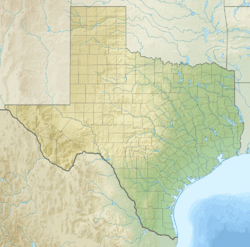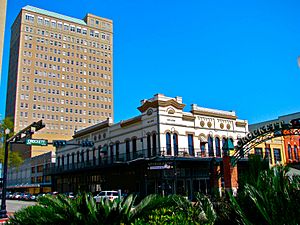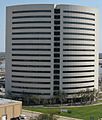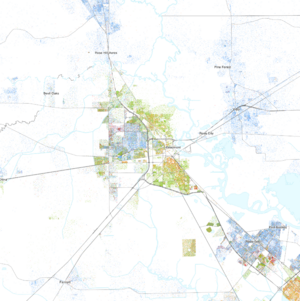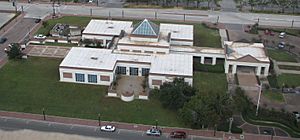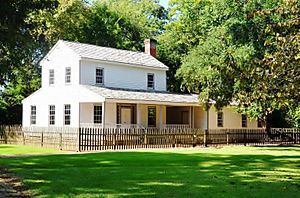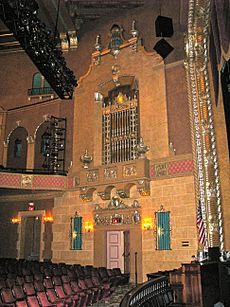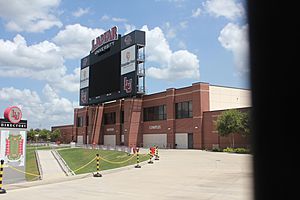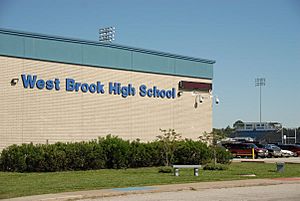Beaumont, Texas facts for kids
Quick facts for kids
Beaumont
|
||
|---|---|---|
| City of Beaumont | ||
|
From top, left to right: Downtown, Port of Beaumont, Lamar University Sports Complex, Hotel Beaumont, Fire Museum of Texas, Tyrrell Historical Library, Crockett Street Entertainment District, Neches River Lift Bridge
|
||
|
||
| Country | United States | |
| State | Texas | |
| County | Jefferson | |
| Settled | 1835 | |
| Incorporation | 1838 | |
| Government | ||
| • Type | Council-Manager | |
| Area | ||
| • City | 85.19 sq mi (220.64 km2) | |
| • Land | 82.46 sq mi (213.56 km2) | |
| • Water | 2.73 sq mi (7.08 km2) | |
| Elevation | 16 ft (5 m) | |
| Population
(2020)
|
||
| • City | 115,282 | |
| • Estimate
(2022)
|
112,089 | |
| • Density | 1,353.23/sq mi (522.489/km2) | |
| • Urban | 147,922 (222nd U.S.) | |
| • Metro | 404,872 (130th U.S.) | |
| • Demonym | Beaumonter | |
| Time zone | UTC−6 (CST) | |
| • Summer (DST) | UTC−5 (CDT) | |
| ZIP codes |
77701–77710, 77713, 77720, 77725, 77726
|
|
| Area code(s) | 409 | |
| FIPS code | 48-07000 | |
| GNIS feature ID | 2409806 | |
Beaumont is a city in the U.S. state of Texas. It is the main city of Jefferson County. Beaumont is part of the larger Beaumont–Port Arthur area. It is located in Southeast Texas on the Neches River. The city is about 85 miles (137 km) east of Houston.
In 2020, Beaumont had a population of 115,282 people. This makes it the largest city near the Louisiana border. Its larger metropolitan area was the 10th biggest in Texas in 2020.
Beaumont was started in 1838. Early on, its economy relied on lumber, farming, and its port. In 1892, Joseph Eloi Broussard opened the first successful rice mill in Texas. This helped rice farming grow a lot in the area.
A huge change happened in 1901 with the Spindletop oil discovery. This showed there was a massive oil field nearby. Many energy companies started in Beaumont because of this. The area quickly became a major place for refining oil and chemicals. Beaumont, along with Port Arthur and Orange, forms the "Golden Triangle." This is a big industrial area on the Texas Gulf Coast.
Beaumont is home to Lamar University. This is a research university with over 14,000 students. The ExxonMobil Beaumont Refinery is the city's largest private employer. It covers more than 2,000 acres.
Contents
History of Beaumont
Early Settlements and Founding
In 1824, Noah and Nancy Tevis started a farm on the west bank of the Neches River. A small community grew around it, called Tevis Bluff. In 1835, this land was bought by Henry Millard, Joseph Pulsifer, and Thomas Byers Huling. They planned a town and named it Beaumont. It was named after Mary Dewburleigh Barlace Warren Beaumont, Henry Millard's wife.
Beaumont officially became a town on December 16, 1838. Its first mayor was Alexander Calder. Early businesses included real estate, shipping, and retail. The Port of Beaumont became an important shipping hub.
Growth of Industries
In its early years, Beaumont was a small center for cattle ranchers and farmers. By the 1880s, it became a key town for lumber and rice milling. The city exported rice as a major crop. The lumber industry grew quickly after the Civil War. This was because railroads were being rebuilt and expanded.
The Beaumont Rice Mill, started in 1892 by Joseph Eloi Broussard, was the first successful rice mill in Texas. He also helped create the Beaumont Irrigation Company in 1898. This company provided water for growing rice. Thanks to these efforts, rice farming expanded from 1,500 acres in 1892 to 400,000 acres across 23 counties by 1956.
The Oil Boom
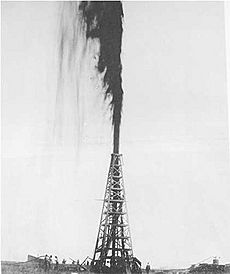
A huge event happened on January 10, 1901, when oil was found at nearby Spindletop. This was the first major oil field in America. After oil was discovered, Beaumont's population grew very fast. It more than tripled in just two months, from 9,000 people in January 1901 to 30,000 by March 1901.
Many new businesses started because of the oil boom. William Casper Tyrrell, a leading businessman, invested in the port and irrigation systems. He also helped develop new homes and shops. Tyrrell was also a kind person. He bought and gave the old First Baptist Church building to the city to be its first public library. Today, it is known as the Tyrrell Historical Library.
World War II and Beyond
During World War II, Beaumont became a big center for building ships for defense. Many people moved to the city for these new jobs. With so many new people, there were some challenges as different groups learned to live and work together.
After the war, Beaumont's port remained important. New highways led to the growth of suburbs. Recently, downtown Beaumont and other parts of the city have been renewed. In 1996, the courts in Beaumont were the first in the nation to use electronic filing for court documents. This made things much faster and saved paper.
Beaumont has faced challenges from hurricanes. In 2005 and 2008, Hurricane Rita and Hurricane Ike caused a lot of damage. People had to leave the city for safety. In August 2017, Hurricane Harvey brought severe flooding. Many residents needed to be rescued by boats and helicopters.
Geography of Beaumont
Beaumont is located on Texas' coastal plain. It is about 30 miles (48 km) inland from the Gulf of Mexico. The city is bordered on the east by the Neches River and to the north by Pine Island Bayou. Beaumont is quite flat, being only 16 feet (5 meters) above sea level.
City Growth
Over time, several smaller towns and communities have become part of Beaumont. These include Amelia, Elizabeth, Elwood (later Voth), Guffey, Santa Anna, and Tevis Bluff.
City Buildings and Design
Beaumont has several tall buildings. The tallest is the Edison Plaza, which is 254 feet (77 meters) tall. The old Edson Hotel, built in 1928, is almost as tall. The 15-story San Jacinto Building, built in 1921, has one of the largest four-faced clock towers in the country. Each clock face is 17 feet (5.2 meters) wide.
The Jefferson Theatre was built in 1927. It was a grand theater for many years. The City Hall and Auditorium, built in 1928, is now the Julie Rogers Theater.
Beaumont's Jefferson County Courthouse is one of the tallest courthouses in Texas. It is a great example of Art Deco style. The Kyle Building, built in 1933, has a restored storefront. It is considered one of the best examples of Zig-Zag architecture in Texas. The Oaks Historic District has many beautiful old homes.
Weather and Climate
Beaumont has a humid subtropical climate. It gets a lot of rain, more than 60 inches (1,500 mm) each year. The city has a wet season from April to October and a dry season from November to March.
Hurricanes can be a threat to the city. Hurricane Rita in 2005 and Hurricane Ike in 2008 caused a lot of damage. Hurricane Harvey in 2017 and Tropical Storm Imelda in 2019 caused historic flooding.
While snow is rare, it does happen sometimes. For example, in December 2017, Beaumont received 3 inches (7.6 cm) of snow.
People of Beaumont
Population and Diversity
| Historical population | |||
|---|---|---|---|
| Census | Pop. | %± | |
| 1850 | 171 | — | |
| 1890 | 3,296 | — | |
| 1900 | 9,427 | 186.0% | |
| 1910 | 20,640 | 118.9% | |
| 1920 | 40,422 | 95.8% | |
| 1930 | 57,732 | 42.8% | |
| 1940 | 59,061 | 2.3% | |
| 1950 | 94,014 | 59.2% | |
| 1960 | 119,175 | 26.8% | |
| 1970 | 117,548 | −1.4% | |
| 1980 | 118,067 | 0.4% | |
| 1990 | 114,177 | −3.3% | |
| 2000 | 113,866 | −0.3% | |
| 2010 | 118,296 | 3.9% | |
| 2020 | 115,282 | −2.5% | |
| U.S. Decennial Census 2020 | |||
In 2020, Beaumont's population was 115,282. The city has a diverse population. Many different racial and ethnic groups live there. The number of people identifying as Black or African American has grown. The Hispanic or Latino population has also increased.
Religious Life

Most people in Beaumont identify as Christian. Baptists are a large group among Protestants. Roman Catholicism is the single largest Christian group. This is partly due to the area's history and its growing Hispanic population.
Besides Christianity, Islam is the second largest religion in the city. There is also a Jewish community in Beaumont. Different religious groups in the city work together on community projects.
Beaumont's Economy
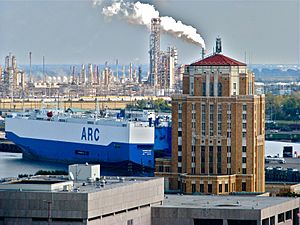
Beaumont's economy is strong. Many people work for Lamar University and the Beaumont Independent School District. ExxonMobil Corporation's Beaumont Refinery is a very large employer. Hospitals like Christus St. Elizabeth Hospital and Baptist Hospital also employ many people.
The Port of Beaumont is a key part of the region's economy. It is one of the largest seaports in the United States by how much cargo it handles. Military transportation units are also based at the port.
Several large industrial facilities are located near Beaumont. These include chemical plants owned by ExxonMobil, Goodyear, and DuPont. Jason's Deli, a popular restaurant chain, has its headquarters in Beaumont. Other important businesses from the area include The Texas Coffee Company, which was the first to package coffee in vacuum-packed foil bags.
Culture and Fun
Arts and Entertainment
Beaumont has many museums and historic buildings to visit. The Art Museum of Southeast Texas (AMSET) shows American art from the 1800s to today. It focuses on Texas art and folk art. Admission is free, and it's open every day.
The Beaumont Children's Museum opened in 2012. The Babe Didrikson Zaharias Museum celebrates the life of a famous athlete from Beaumont. The Beaumont Art League is the oldest non-profit art gallery in the area. It has been open for 70 years.
The historic Chambers House, built in 1906, is open for tours. It shows what life was like long ago. The Clifton Steamboat Museum honors military and civilian heroes. It also tells the story of steamboats. It has a special gallery for the Boy Scouts of America.
The Dishman Art Museum at Lamar University has European, American, and Tribal art. You can also visit the Edison Museum (about inventor Thomas Edison) and the Fire Museum of Texas. The Fire Museum has one of the world's largest fire hydrants!
The McFaddin-Ward House is a large historic home built in 1905. It shows how a prominent family lived for 75 years. The Spindletop-Gladys City Boomtown Museum has reconstructed buildings from the oil boom era. The Texas Energy Museum tells the story of the Spindletop oil discovery.
The Jefferson Theater, built in 1927, hosts live music and shows. It is a historic landmark. The Symphony of Southeast Texas has been performing concerts since 1953.
Things to Do and See
The Beaumont Botanical Gardens are located in the 500-acre Tyrrell Park. They have over ten themed gardens and a large conservatory. Tyrrell Park also has a golf course, a nature area, and a nature trail.
Downtown Beaumont is a lively place. The Crockett Street Entertainment Complex offers dancing, live music, and dining. Downtown also has a museum district with five museums. The Event Centre and plaza is a large outdoor space for concerts and walks. The Beautiful Mountain Skate Plaza is a place for skateboarding.
Sports in Beaumont
Beaumont has been home to many sports teams. The Southeast Texas Mavericks basketball team used to be here. The Texas Strikers are a professional indoor soccer team.
Baseball teams like the Beaumont Exporters and the Beaumont Golden Gators played in the city. The Texas Wildcatters were an ice hockey team. The Beaumont Drillers were a football team.
University Sports
Lamar University has sports teams called the Lamar Cardinals. They compete in Division I of the NCAA. The Cardinals and Lady Cardinals play in 17 different sports. The basketball team plays in the Montagne Center. The baseball team plays in Vincent-Beck Stadium.
Lamar University brought back its football team in 2010. The Provost Umphrey Stadium was fully renovated for this. The football team now competes in the NCAA Division I Football Championship Subdivision.
Education in Beaumont
Colleges and Universities
Lamar University
Beaumont has one state university, Lamar University. It started in 1923 as South Park Junior College. Lamar University is known as a national research university. It offers over 100 different degrees. Popular subjects include business, nursing, teaching, and engineering. The university's enrollment has grown a lot, with over 14,966 students in 2015.
Lamar Institute of Technology
Lamar Institute of Technology is next to Lamar University. It is a technical college that offers two-year degrees and certificates. It became a separate school in 1995. In 2014, it had 2,920 students.
Schools for Kids
Beaumont is served by the Beaumont Independent School District. There are also several private schools.
High schools include:
- Early College High School
- West Brook Senior High School
- Beaumont United High School
- Monsignor Kelly Catholic High School
- Texas Academy of Leadership in the Humanities
The Roman Catholic Diocese of Beaumont runs three Catholic elementary schools. Monsignor Kelly Catholic High School is the city's only Catholic high school. Legacy Christian Academy serves students from pre-kindergarten through 12th grade.
Media in Beaumont
Newspapers
The Beaumont Enterprise is the daily newspaper for Beaumont. It has been operating since 1880. Two weekly papers, The Examiner and The Southeast Texas Record, also serve the area.
Television
| Channel | Call Sign | Network | Subchannels |
|---|---|---|---|
| 4 | KBTV | Dabl | TBD on 4.2, Comet TV on 4.3, Stadium on 4.4, Charge! on 4.5 |
| 6 | KFDM | CBS | The CW Plus on 6.2, Fox on 6.3 |
| 12 | KBMT | ABC | NBC on 12.2, Cozi TV on 12.3, MeTV on 12.4, True Crime on 12.7, Quest on 12.8, Twist on 12.16 |
| 22 | KUMY-LD | NewsNet | |
| 27 | KAOB-LD | Heartland | Vidor Television on 27.2, The Family Channel on 27.3, Familia TV on 27.4, Rev'n on 27.5, Retro Television Network on 27.6, KHTW Audio Simulcast on 27.7 |
| 34 | KITU-TV | TBN (O&O) | Hillsong Channel on 34.2, Smile on 34.3, Enlace on 34.4, Positiv on 34.5 |
Lamar University has its own video services, LUTV and LUTV Channel 7. They show local government meetings and student-made programs.
Radio
| Frequency | Call letters / licensed to (if not Beaumont) | Format | Owner | Notes |
|---|---|---|---|---|
| 560 | KLVI | News, Talk radio | iHeartMedia | |
| 990 | KZZB | Gospel "Gospel 990" | Martin Broadcasting | |
| 1150 | KBPO (Port Neches) | Spanish-language Christian Radio | Christian Ministries of the Valley | |
| 1250 | KDEI (Port Arthur) | Catholic radio | Radio Maria | |
| 1300 | KWTH (Lumberton; Was MusicRadio KLLS in AM Stereo from 2015 to 2019) | Tejano | ||
| 1340 | KOLE (Port Arthur) | Various | Birach Broadcasting | |
| 1450 | KIKR | Sports "Sports Radio 1450/1510 AM" | Cumulus Broadcasting | |
| 1510 | KBED (Nederland) | Sports "Sports Radio 1450/1510 AM" | Cumulus Broadcasting | Simulcast of KIKR only during daytime hours |
| 1600 | KOGT (Orange) | Country | ||
| 88.1 | KLBT | Contemporary Christian | The King's Musician Educational Foundation | |
| 88.5 | KGHY | Southern Gospel "The Gospel Highway" | CCS Radio | |
| 89.7 | KTXB | Christian radio "Family Radio" | Family Stations | |
| 90.5 | KZFT (Fannett) | Christian radio | AFR | |
| 91.3 | KVLU | Public Radio | Lamar University | |
| 92.5 | KCOL (Groves) | Oldies "Cool 92.5" | iHeartMedia | |
| 93.3 (Port Arthur) | KQBU | Regional Mexican "Que Buena 93.3" | Univision | |
| 94.1 | KQXY | CHR "Q94" | Cumulus Broadcasting | |
| 95.1 | KYKR | Country "Kicker 95.1" | iHeartMedia | |
| 97.1 | KLVH (Cleveland) | Contemporary Christian "K-Love" | Educational Media Foundation | |
| 97.5 | KFNC (Mont Belvieu) | Sports "ESPN 97.5" | Gow Media-Houston | |
| 98.5 | KTJM (Port Arthur) | Regional Mexican "La Raza 98.5/103.3" | Liberman Broadcasting-Houston | |
| 99.9 | KHIH (Liberty) | Contemporary Christian "KSBJ" | KSBJ Educational Foundation, Inc. | |
| 100.7 | KKHT (Lumberton) | Christian radio "100.7 The Word" | Salem Broadcasting | |
| 101.7 | KAYD (Silsbee) | Country "KD101" | Cumulus Broadcasting | |
| 102.5 | KTCX | Urban contemporary "Magic 102.5" | Cumulus Broadcasting | |
| 103.3 | K277AG (Beaumont) | Hip-Hop, R&B "The Beat 103.3" | iHeartMedia | Simulcast of KKMY-HD2 |
| 104.5 (Orange) | KKMY | Rhythmic CHR "104.5 Kiss FM" | iHeartMedia | |
| 105.3 | KLTW (Winnie) | (with Walton and Johnson mornings) | Educational Media Foundation | |
| 106.1 | KIOC (Orange) | Rock "Big Dog 106" | iHeartMedia | |
| 106.9 | KHPT (Conroe) | Classic Rock "The Eagle 106.9" (107.5 simulcast KGLK) | Urban One | |
| 107.9 | KQQK | Regional Mexican "107.9 El Norte" | Liberman Broadcasting-Houston |
Getting Around Beaumont
Airports and Port
Jack Brooks Regional Airport (BPT) is about 9 miles (14 km) south of downtown Beaumont. It has flights to Dallas/Fort Worth Airport (DFW). The Beaumont Municipal Airport (BMT) is for smaller planes.
The Port of Beaumont is on the Neches River. It is a very busy port.
Train and Bus Travel
Amtrak's Sunset Limited train stops at the Beaumont train station. The city also has a bus system called the Beaumont Municipal Transit System (BMT).
Main Roads
Major highways that go through Beaumont include:
Famous People from Beaumont
Many talented people have come from Beaumont, Texas. Some are famous athletes, musicians, and actors.
- Mildred Ella ("Babe") Didrikson Zaharias was an Olympic champion and Hall of Fame golfer.
- Johnny Winter and Edgar Winter were brothers who became famous rock and blues musicians.
- Harry James was a well-known musician and bandleader.
- J.P. Richardson, also known as "The Big Bopper," was a rock & roll singer.
- Irma P. Hall is an actress known for movies like Soul Food.
- Kendrick Perkins is a professional basketball player.
- Jay Bruce is a professional baseball player and a three-time All-Star.
- Tracy Byrd and Mark Chesnutt are popular country music artists.
See also
 In Spanish: Beaumont (Texas) para niños
In Spanish: Beaumont (Texas) para niños











